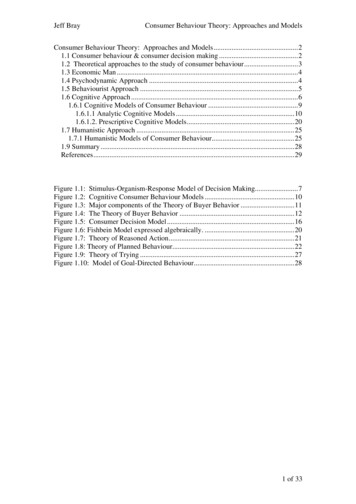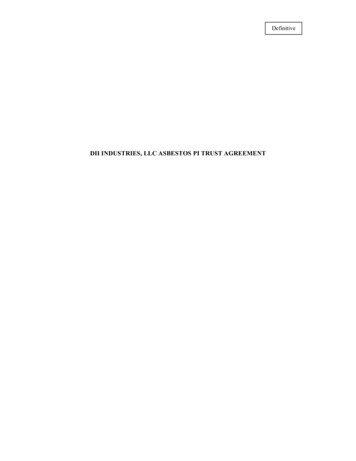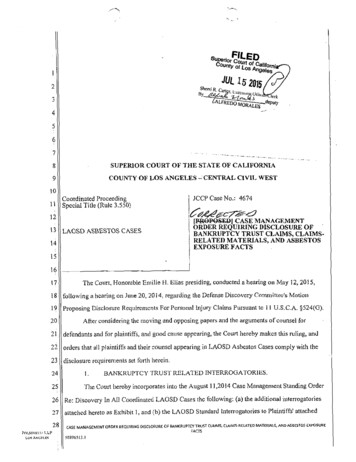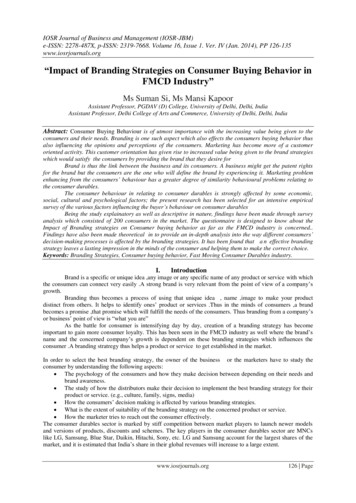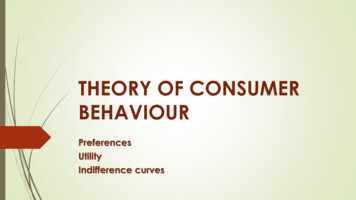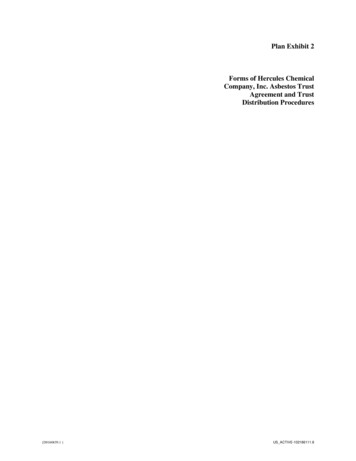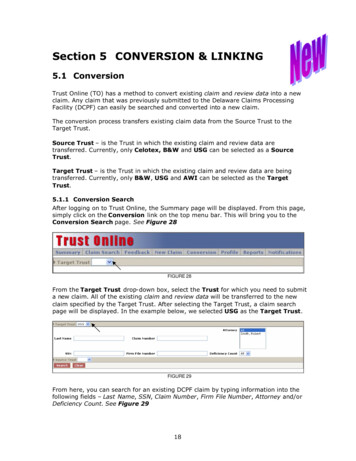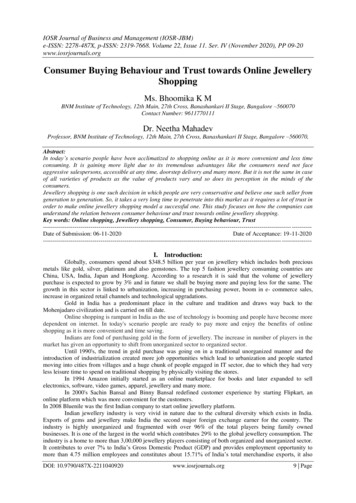
Transcription
IOSR Journal of Business and Management (IOSR-JBM)e-ISSN: 2278-487X, p-ISSN: 2319-7668. Volume 22, Issue 11. Ser. IV (November 2020), PP 09-20www.iosrjournals.orgConsumer Buying Behaviour and Trust towards Online JewelleryShoppingMs. Bhoomika K MBNM Institute of Technology, 12th Main, 27th Cross, Banashankari II Stage, Bangalore –560070Contact Number: 9611770111Dr. Neetha MahadevProfessor, BNM Institute of Technology, 12th Main, 27th Cross, Banashankari II Stage, Bangalore –560070,Abstract:In today’s scenario people have been acclimatized to shopping online as it is more convenient and less timeconsuming. It is gaining more light due to its tremendous advantages like the consumers need not faceaggressive salespersons, accessible at any time, doorstep delivery and many more. But it is not the same in caseof all varieties of products as the value of products vary and so does its perception in the minds of theconsumers.Jewellery shopping is one such decision in which people are very conservative and believe one such seller fromgeneration to generation. So, it takes a very long time to penetrate into this market as it requires a lot of trust inorder to make online jewellery shopping model a successful one. This study focuses on how the companies canunderstand the relation between consumer behaviour and trust towards online jewellery shopping.Key words: Online shopping, Jewellery shopping, Consumer, Buying behaviour, ------------------------------ ---------Date of Submission: 06-11-2020Date of Acceptance: ------------------------------ ---------------I. Introduction:Globally, consumers spend about 348.5 billion per year on jewellery which includes both preciousmetals like gold, silver, platinum and also gemstones. The top 5 fashion jewellery consuming countries areChina, USA, India, Japan and Hongkong. According to a research it is said that the volume of jewellerypurchase is expected to grow by 3% and in future we shall be buying more and paying less for the same. Thegrowth in this sector is linked to urbanization, increasing in purchasing power, boom in e- commerce sales,increase in organized retail channels and technological upgradations.Gold in India has a predominant place in the culture and tradition and draws way back to theMohenjadaro civilization and is carried on till date.Online shopping is rampant in India as the use of technology is booming and people have become moredependent on internet. In today's scenario people are ready to pay more and enjoy the benefits of onlineshopping as it is more convenient and time saving.Indians are fond of purchasing gold in the form of jewellery. The increase in number of players in themarket has given an opportunity to shift from unorganized sector to organized sector.Until 1990's, the trend in gold purchase was going on in a traditional unorganized manner and theintroduction of industrialization created more job opportunities which lead to urbanization and people startedmoving into cities from villages and a huge chunk of people engaged in IT sector, due to which they had veryless leisure time to spend on traditional shopping by physically visiting the stores.In 1994 Amazon initially started as an online marketplace for books and later expanded to sellelectronics, software, video games, apparel, jewellery and many more.In 2000's Sachin Bansal and Binny Bansal redefined customer experience by starting Flipkart, anonline platform which was more convenient for the customers.In 2008 Bluenile was the first Indian company to start online jewellery platform.Indian jewellery industry is very vivid in nature due to the cultural diversity which exists in India.Exports of gems and jewellery make India the second major foreign exchange earner for the country. Theindustry is highly unorganized and fragmented with over 96% of the total players being family ownedbusinesses. It is one of the largest in the world which contributes 29% to the global jewellery consumption. Theindustry is a home to more than 3,00,000 jewellery players consisting of both organized and unorganized sector.It contributes to over 7% to India’s Gross Domestic Product (GDP) and provides employment opportunity tomore than 4.75 million employees and constitutes about 15.71% of India’s total merchandise exports, it alsoDOI: 10.9790/487X-2211040920www.iosrjournals.org9 Page
Consumer Buying Behaviour and Trust towards Online Jewellery Shoppingcontributes a major chunk to the total foreign reserves of the country. UAE, US, Russia, Singapore, Hongkong,China are the biggest importers of Indian jewellery.The existing literature gives various inputs for the current research.Variety, value for money and delivery are the important attributes in case of online shopping. In- storeshoppers looked for social interaction and personalized attention. Control of shopping experience was thedesired value for utilitarian purchase irrespective of the channel of purchase(Haidasan, Gautami& Fernando,2018). In a study conducted by Walia and Jha Manish (2015), it was found out that information, usefulness, easeof use, privacy and perceived enjoyment are the factors which influence consumer while purchasing online.About security and privacy concerns, research reveals that even though there is an increase inconsumer demand, consumers are skeptical regarding the privacy of information and delivery system prevailingin online business. These may not encourage new entrants into this market(Fazeen, 2017). However, there is analternate view to this in a research conducted by ThuraSoe (2019), which revealed that consumer privacy andsecurity is not affected in case of e-commerce purchase in Myanmar. It is due to the trust that lies in thecustomers towards the organization. The other factors which influence the consumers are website quality andthe reputation of the organization. A study by Corbitt, Thanasankit and Han Yj (2013) also reveals that theconsumers would prefer to purchase online only if they have trust and have experience using the web. Trustlevels of the consumer are likely to be influenced by the website quality, technical trustworthiness and theshopping experience on the site.Trust is found todirectly and indirectly affect the consumer buying behaviourand also impacts theconsumer loyalty towards an organization. The study also reveals that it has a threefold effect on the consumerbehaviour that is pre purchase, purchase and post purchase behaviour (Kim, Ferrin and Rao, 2008). Kalia, Kaurand Singh (2016)identified twentysix factors which affect the consumer behaviour while purchasing online. Thefactors which were prioritized by the consumers were price, convenience, security, information and access to thewebsite impacted the most while making the decision.Xiaotian and Jamal (2018)emphasize on trust betweenthe consumer and the provider of the product or service. The authors analyzed that the core factor to gainconsumer trust was through a two-way communication. The organization should not use it as a tool just for thesake of communication but utilize it as a medium for building trust among the consumers.In addition to the trust factor, a better understanding of consumer behavior helps the organization todevelop strategies related to potential and actual customers. Ease of use, vendor’s characteristics, usefulness,website design, trust and risk are the important parameters considered while purchasing onlineVaghela (2019).However, Kumar (2019) foundthat the penetration of e-commerce is low in India and the mostpreferred mode of payment system is Cash on delivery owing to 75% of the total transactions.Research objectives: To study the demography of the consumers desiring to buy online jewellery. To understand how trust increases among customers by implementing credible marketing strategies.Scope of the study:The study is confined to identify the relation of trust with the consumer buying behaviour inBanagalore city and focuses only on online shopping as it is easy to build trust in a traditional setup whencompared to a virtual setup that is online shopping. it helps the organisation to understand how to framemarketing strategies in order to build trust among the consumers. The demographic factors considered arerestricted to age, income and gender.Research methodology:Descriptive type of research was being conducted and primary data was collected through convenientand snowball sampling from 86 respondents by using Google forms. The various tools used in the study foranalysis are Excel, SPSS and Tableau. Analysis is derived by using chi-square test, prediction analysis andcorrelation.DOI: 10.9790/487X-2211040920www.iosrjournals.org10 Page
Consumer Buying Behaviour and Trust towards Online Jewellery ShoppingHypothesis:Hypothesis 1H0: There is no relation between trust and consumer buying behaviour towards online jewellery shopping.H1: There is a relation between trust and consumer buying behaviour towards online jewellery shopping.Hypothesis 2H0: Age does not influence consumer perception towards online jewellery shopping.H1: Age influences consumer perception towards online jewellery shopping.Hypothesis 3H0: Gender does not influence consumer perception towards online jewellery shopping.H1: Gender influences consumer perception towards online jewellery shopping.Hypothesis 4H0: Household income does not influence consumer perception towards online jewellery shopping.H1: Household income influences consumer perception towards online jewellery shopping.Analysis:Table 1: AgeAge 18 years18-25 years25-35 years35-45 years 45 1.6%12.8%16.3%It is found out that majority of the respondents are between the age group of 18 years to 25 years whichindicates that they are the ones who are most involved into usage of technology and the youth which accepts anysort of new things which is bought up in the society. They are ready to accept the change which takes place.Table 2: ge45.3%54.7%We can observe that highest number of responses were received from women, a study shows that menare not inclined much towards online shopping and another reason for female majority is that theproduct(jewellery) has a higher sentimental value and attachment in the hearts of women when compared to thatof men.Table 3: Household incomeHousehold income Rs.1,00,000Rs.1,00,000 – Rs.3,00,000Rs.3,00,000 – Rs.5,00,000Rs.5,00,000 – Rs.10,00,000 .1%24.4%22.1%23.3%15.1%Table 4: Attitude towards online jewellery shoppingAttitude towards online jewelleryshoppingExtremely usefulVery usefulModerately usefulSlightly usefulNot at all r9.3%15.12%23.25%22.09%30.24%We can observe that majority of the consumers opined that online shopping is not at all useful, we caninfer from this that the consumers have not acclimatized to the new technological upgradations and feelcomfortable in purchasing it in an offline or a traditional setup by directly and physically visiting the store.DOI: 10.9790/487X-2211040920www.iosrjournals.org11 Page
Consumer Buying Behaviour and Trust towards Online Jewellery ShoppingTable 5: Frequency of online jewellery purchaseFrequency of online jewellery purchaseWeeklyMonthlyOnce in 6 ilver0%3.49%18.7%38.37%39.53%We can observe that majority of them never purchase gold and silver jewellery online, we can inferthat people are not exposed to this way of purchase and are comfortable in shopping such goods in a traditionaloffline store, the customers prefer direct conversation with the sales executive in order to close a deal. Hence,we can see majority of them either buy it rarely or neither make any online transactions.Table 6:Affects bargaining power due to online purchaseAffects bargaining power due to onlinepurchaseStrongly agreeAgreeNo opinionDisagreeStrongly .1%15.1%5.8%1.2%We can observe that majority of them strongly agree this may be due to continuous exposure ofconsumers towards traditional offline stores. In case of traditional stores, the consumers have an opportunity tohave direct conversation with the sales executive.Table 7: bargaining power will be sufficed with online discountsbargaining power will be sufficed with onlinediscountsStrongly agreeAgreeNo opinionDisagreeStrongly .3%33.7%18.6%9.3%We can observe that majority of the respondents have no opinion which can be inferred that they aresometimes satisfied with the discounts and sometimes they are not satisfied. The next highest votes are fordisagree which means that the consumers feel that they get much more discounts when they directly visit atraditional store as they can bargain which is not possible in an online setup.Table 8: Preferred mode of purchasePreferred mode of purchaseSearch online & Buy offlineSearch online & Buy onlineTotalFrequency652186Percentage75.6%24.4%We can observe that the majority of the consumers opined that search online and buy offline is the bestoption as e commerce has not penetrated much into the Indian markets for jewellery and people have not readilyaccepted it due to privacy issues, payment systems and virtual aspects which bring anxiety in the minds of theconsumersDOI: 10.9790/487X-2211040920www.iosrjournals.org12 Page
Consumer Buying Behaviour and Trust towards Online Jewellery ShoppingTable 9: Tableau graph for GoldFrom the above graph we can predict that both male and female respondents in the age group of 18-25 years,with a household income between Rs.1 lakh to Rs.3 lakhs are likely to buy gold jewellery through online rarely.Table 10:From the above graph we can predict that both male and female respondents in the age group of 18-25 years,with a household income between Rs.1 lakh to Rs.3 lakhs are likely to buy silver jewellery through onlinerarely.HYPOTHESIS :1Statement 1.1: Trust and consumer behavior towards online jewellery of gold are related.H0: There is no relation between trust and consumer buying behaviour towards online jewellery shopping ofGOLD.H1: There is a relation between trust and consumer buying behaviour towards online jewellery shopping ofGOLD.DOI: 10.9790/487X-2211040920www.iosrjournals.org13 Page
Consumer Buying Behaviour and Trust towards Online Jewellery ShoppingTable 11: Correlation table of consumer behavior and trust towards online jewellery shopping of GOLD.AABCDEFGHPearson's rp valueBCDEFGHPearson's r0.510***p value 0.001Pearson's r0.091-0.089p value0.4070.416Pearson's r0.096-0.0680.874***p value0.380.537 0.001Pearson's r0.072-0.1070.698***0.728***p value0.510.328 0.001 0.001Pearson's r0.129-0.0820.866***0.874***0.753***p value0.2380.453 0.001 0.001 0.001Pearson's r0.098-0.0620.805***0.844***0.794***0.879***p value0.3680.572 0.001 0.001 0.001 0.001Pearson's **p value0.5550.42 0.001 0.001 0.001 0.001 0.001Aattitude towards online jewellery shopping*P 0.05Bfrequency of purchase**P 0.01Csecured payment system***P 0.001Dconfidentiality of personal informationEreputation of the firmFguarantee of productGtimeliness of deliveryHafter sale serviceThe consumer behavior factors are attitude of consumers towards online jewellery and the frequency ofpurchase, the trust factors considered are secured payment system, confidentiality of information, reputation ofthe firm, guarantee of the product, timeliness of delivery and after sale service.To find the significant relation between consumer behavior and trust towards online jewellery shoppingof GOLD, the statistical tool used is Pearson’s Correlation and it was found that there is NO significant relationbetween the trust and consumer behavior factors as all the calculated values of r is less than 0.5, hence weaccept Null hypothesis.We can also identify that there is a strong correlation among the trust factors.Result:Null hypothesis (H0) is accepted and alternative hypothesis (H1) is rejected. Therefore, there is no relationbetween trust and consumer buying behavior towards online jewellery shopping of GOLD.Statement 1.2: Trust and consumer behavior towards online jewellery of gold are related.H0: There is no relation between trust and consumer buying behaviour towards online jewellery shopping ofSILVER.H1: There is a relation between trust and consumer buying behaviour towards online jewellery shopping ofSILVER.DOI: 10.9790/487X-2211040920www.iosrjournals.org14 Page
Consumer Buying Behaviour and Trust towards Online Jewellery ShoppingTable 12: Correlation table of consumer behavior and trust towards online jewellery shopping ofSILVER.ABCDEFGHPearson's rAp valuePearson's rBCDEFGH0.426***p value 0.001Pearson's r0.215*0.008p value0.0470.943Pearson's r0.072-0.012p value0.5080.91 0.001Pearson's r0.102-0.030.799***0.806***p value0.3510.784 0.001 0.001Pearson's r0.103-0.0570.875***0.858***p value0.3440.605 0.001 0.001 0.001Pearson's r0.1330.0290.846***0.856***0.868***0.891***p value0.2210.789 0.001 0.001 0.001 0.001Pearson's ***p value0.9430.377 0.001 0.001 0.001 0.001 0.0010.852***0.894***Aattitude towards online jewellery shopping*P 0.05Bfrequency of purchase**P 0.01Csecured payment system***P 0.001Dconfidentiality of personal informationEreputation of the firmFguarantee of productGtimeliness of deliveryHafter sale serviceThe consumer behavior factors are attitude of consumers towards online jewellery and the frequency ofpurchase, the trust factors considered are secured payment system, confidentiality of information, reputation ofthe firm, guarantee of the product, timeliness of delivery and after sale service.To find the significant relation between consumer behavior and trust towards online jewellery shopping ofSILVER, the statistical tool used is Pearson’s Correlation and it was found that there is moderate relationbetween the SECURED PAYMENT SYTEM (trust factor)and ATTITUDE TOWARDS ONLINEJEWELLERY SHOPPING (consumer behavior factor) and not a strong relation as all the calculated values of rnearing to 0.5, hence we reject Null hypothesis.We can also identify that there is a strong correlation among the trust factors.Result:Alternative hypothesis (H1) is accepted and Null hypothesis (H0) is rejected. Therefore, there is a relationbetween trust and consumer buying behavior towards online jewellery shopping of SILVER.HYPOTHESIS: 2Statement 2.1: Age and perception towards online jewellery shopping of gold are related.H0: AGE does not influence the consumer perception towards online jewellery shopping of GOLD.H1: AGE influences the consumer perception towards online jewellery shopping of GOLD.DOI: 10.9790/487X-2211040920www.iosrjournals.org15 Page
Consumer Buying Behaviour and Trust towards Online Jewellery ShoppingTable 4.12: Pivot table of age and perception towards online jewellery shopping of GOLD.attitude towards online jewellery shopping (GOLD)extremely usefulmoderatelyuseful 18 years0118-25 years6825-35 years1335-45 years03 45 years118total81635AGEnot at allusefulslightlyusefulvery useful3004161254722210611112214171086totalChi square testchi square testꭓ2Nvaluedfp12.2160.72986To find the significant relation between age and perception towards online jewellery shopping of GOLD , thestatistical tool used is Chi-square test and it was found that the calculated value that is p is equal to 0.729 whichis more than the significance level , 0.05, hence we accept Null hypothesis.Result:Null hypothesis (H0) is accepted and alternative hypothesis (H1) is rejected. Therefore, Age does not influencethe consumer perception towards online jewellery shopping of GOLD.Statement 2.2: Age and perception towards online jewellery shopping of gold are related.H0: AGE does not influence the consumer perception towards online jewellery shopping of SILVER.H1: AGE influences the consumer perception towards online jewellery shopping of SILVER.Table 4.13: Pivot table of age and perception towards online jewellery shopping of SILVER.attitude towards online jewellery shopping (SILVER)AGEextremely usefulmoderatelyusefulnot at allusefulslightlyusefulvery usefultotal 18 years00400418-25 years61581354725-35 years121331035-45 years0341311 45 years1092214total82026191386Chi square testchi square testꭓ2Nvaluedfp30.7160.01586To find the significant relation between age and perception towards online jewellery shopping ofSILVER, the statistical tool used is Chi-square test and it was found that the calculated value that is p is equal to0.015 which is less than the significance level , 0.05, hence we reject Null hypothesis.DOI: 10.9790/487X-2211040920www.iosrjournals.org16 Page
Consumer Buying Behaviour and Trust towards Online Jewellery ShoppingResult:Null hypothesis (H0) is rejected and alternative hypothesis (H1) is accepted. Therefore, Age influences theconsumer perception towards online jewellery shopping of SILVER.HYPOTHESIS: 3Statement 3.1: Gender and perception towards online jewellery shopping of gold are related.H0: GENDER does not influence the consumer perception towards online jewellery shopping of GOLD.H1: GENDER influences the consumer perception towards online jewellery shopping of GOLD.Table 4.14: Pivot table of gender and perception towards online jewellery shopping of GOLD.attitude towards online jewellery shopping (GOLD)GENDERextremelyusefulmoderatelyusefulnot at allusefulslightlyusefulvery 1086Chi- square testchi square testvaluedfpꭓ26.240.185N86To find the significant relation between gender and perception towards online jewellery shopping of GOLD, thestatistical tool used is Chi-square test and it was found that the calculated value that is p is equal to 0.185 whichis more than the significance level , 0.05, hence we accept Null hypothesis.Result:Null hypothesis (H0) is accepted and alternative hypothesis (H1) is rejected. Therefore, Gender does notinfluence the consumer perception towards online jewellery shopping of GOLD.Statement 3.2: Gender and perception towards online jewellery shopping of silver are related.H0: GENDER does not influence the consumer perception towards online jewellery shopping of SILVER.H1: GENDER influences the consumer perception towards online jewellery shopping of SILVER.Table 4.15: Pivot table of gender and perception towards online jewellery shopping of SILVER.attitude towards online jewellery shopping e3maletotalnot at allusefulslightlyuseful129581782026very useful15total8474539191386Chi square testchi square testꭓ2Nvaluedfp10.240.03886To find the significant relation between gender and perception towards online jewellery shopping ofSILVER, the statistical tool used is Chi-square test and it was found that the calculated value that is p is equal to0.038 which is less than the significance level , 0.05, hence we reject Null hypothesis.DOI: 10.9790/487X-2211040920www.iosrjournals.org17 Page
Consumer Buying Behaviour and Trust towards Online Jewellery ShoppingResult:Null hypothesis (H0) is rejected and alternative hypothesis (H1) is accepted. Therefore, Gender influences theconsumer perception towards online jewellery shopping of SILVER.HYPOTHESIS: 4Statement 4.1: HouseholdIncome and perception towards online jewellery shopping of gold are related.H0: HOUSEHOLD INCOME does not influence the consumer perception towards online jewellery shopping ofGOLD.H1: HOUSEHOLD INCOME influences the consumer perception towards online jewellery shopping of GOLD.Table 4.16: Pivot table of household income and perception towards online jewellery shopping of GOLD.attitude towards online jewellery shopping (GOLD)INCOMEextremelyusefulmoderatelyusefulnot at allusefulslightlyusefulvery usefultotal Rs.1,00,0000561113 Rs.10,00,0003251213Rs.1,00,000 - Rs.3,00,0000477321Rs.3,00,000 - Rs.5,00,00021121319Rs.5,00,000 - Rs.10,00,0003457120total81635171086Chi square testchi square testꭓ2valuedfp24.9160.07186NTo find the significant relation between household income and perception towards online jewellery shopping ofGOLD, the statistical tool used is Chi-square test and it was found that the calculated value that is p is equal to0.071 which is more than the significance level , 0.05, hence we accept Null hypothesis.Result:Null hypothesis (H0) is accepted and alternative hypothesis (H1) is rejected. Therefore, Household income doesnot influence the consumer perception towards online jewellery shopping of GOLD.Statement 4.2: HouseholdIncome and perception towards online jewellery shopping of gold are related.H0: HOUSEHOLD INCOME does not influence the consumer perception towards online jewellery shopping ofSILVER.H1: HOUSEHOLD INCOME influences the consumer perception towards online jewellery shopping ofSILVER.Table 4.17: Pivot table of household income and perception towards online jewellery shopping ofSILVER.attitude towards online jewellery shopping (SILVER)INCOMEextremelyusefulmoderatelyusefulnot at allusefulslightlyusefulvery usefultotal Rs.1,00,0000553013 Rs.10,00,0002233313Rs.1,00,000 - Rs.3,00,0000666321Rs.3,00,000 - Rs.5,00,0003393119Rs.5,00,000 - Rs.10,00,0003434620total82026191386DOI: 10.9790/487X-2211040920www.iosrjournals.org18 Page
Consumer Buying Behaviour and Trust towards Online Jewellery ShoppingChi square testchi square testꭓ2Nvaluedfp19.1160.26686To find the significant relation between household income and perception towards online jewelleryshopping of SILVER in Sri Rajalakshmi Group of Jewellers, the statistical tool used is Chi-square test and itwas found that the calculated value that is p is equal to 0.266 which is more than the significance level , 0.05,hence we accept Null hypothesis.Result:Null hypothesis (H0) is accepted and alternative hypothesis (H1) is rejected. Therefore, Household income doesnot influence the consumer perception towards online jewellery shopping of SILVER. II. FindingsIt is observed that majority of the respondents felt that online jewellery shopping of SILVER is moderatelyuseful who fall into the age group of 18-25 years.It is observed that majority of the respondents felt that online jewellery shopping of GOLD is not at alluseful who fall into the age group of 18-25 years.It is observed that male respondents felt that online jewellery shopping of SILVER is extremely usefulwhen compared to that of the female respondents.But in case of online jewellery shopping of GOLD female respondents felt it to be extremely useful whencompared to that of the male respondents.It is observed that majority of the respondents would never prefer to buy jewellery from online platformseither it is GOLD or SILVER.Majority of the respondents would purchase SILVER jewellery online for the purpose of gifting.Whereas majority of the respondents preferred buying GOLD jewellery online for their own use.Majority of the respondents opined that their bargaining power is highly affected due to the onlineplatforms of jewellery purchase.It is observed that majority of the respondents had no opinion whether their bargaining power would besufficed with the discounts given online.It is observed that majority of the respondents felt that secured payment system, confidentiality of personalinformation, reputation of the firm, guarantee of the product and timeliness of delivery are very importantfactors to trust an online jewellery platform.Majority of the respondents felt that “Search online and Buy offline” is better when compared to “Searchonline and Buy online”.There is a significant relation among the trust factors.Findings with respect to objective 1(To study the demography of the consumers desiring to buy online jewellery.) From the study we can observe that age and gender of individual bear a direct impact on the perceptiontowards online jewellery shopping. Male and female preferences are completely different from each other when it comes to the perception, it isobserved that male respondents felt online shopping of SILVER is useful but whereas female respondentsfelt online shopping of GOLD is more useful. Age has a direct impact on the consumer perception towards online purchase of SILVER but does notinfluence their perception when it comes to GOLD. This may be due to the higher value of the product incase of GOLD which none of the age groups feel comfortable in buying the same. It is observed that income does not bear an impact on the consumer perception towards online jewelleryshopping whether it is GOLD or SILVER. It is observed that the attitude of consumers towards jewellery is still traditional and requires time tochange.DOI: 10.9790/487X-2211040920www.iosrjournals.org19 Page
Consumer Buying Behaviour and Trust towards Online Jewellery ShoppingFindings with respect to objective 2(To understand how trust increases among customers by implementing credible marketing strategies.) From the study we can find that the trust factor which bears impact on the consumer buying behavior is aSecured payment system, hence the organization should focus on building a secure format which isencrypted and does not hamper the consumer details and misuse them. We can observe that trust has an impact on consumer behavior incase of online jewellery shopping ofSILVER, but trust has no bearing on consumer behavior when it comes to online jewellery shopping ofGOLD.Limitations the comparison is between only trust and buying behaviour. It is confined only to consumers in Bangalore, so findings need not be tr
Jewellery shopping is one such decision in which people are very conservative and believe one such seller from . In 1994 Amazon initially started as an online marketplace for books and later expanded to sell electronics, software, video games, apparel, jewellery and many more. . website impacted the mos



